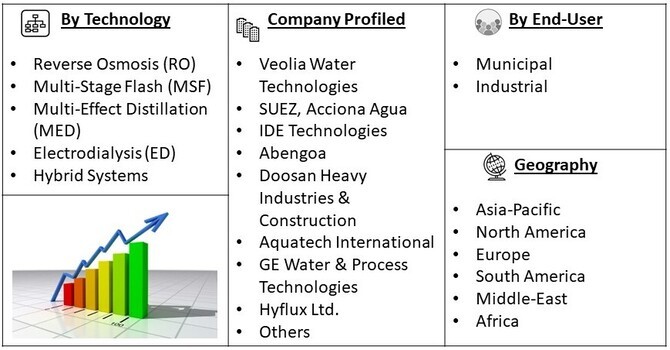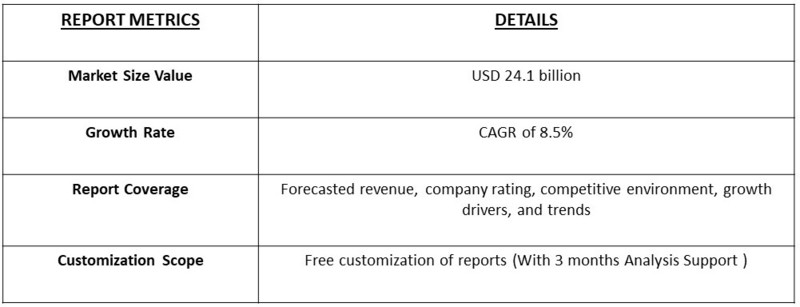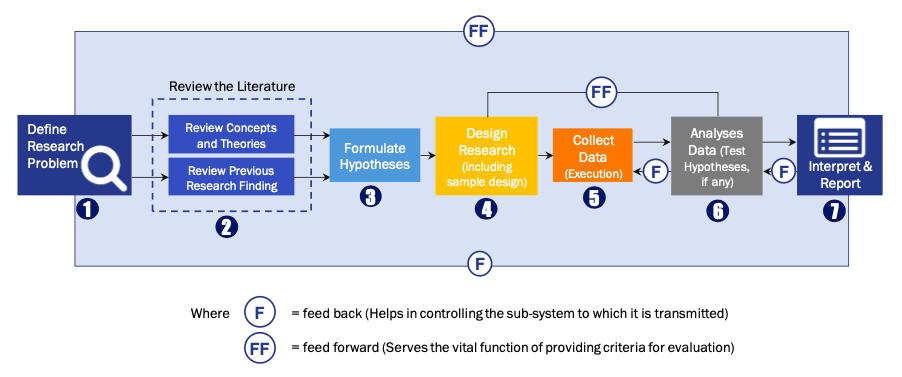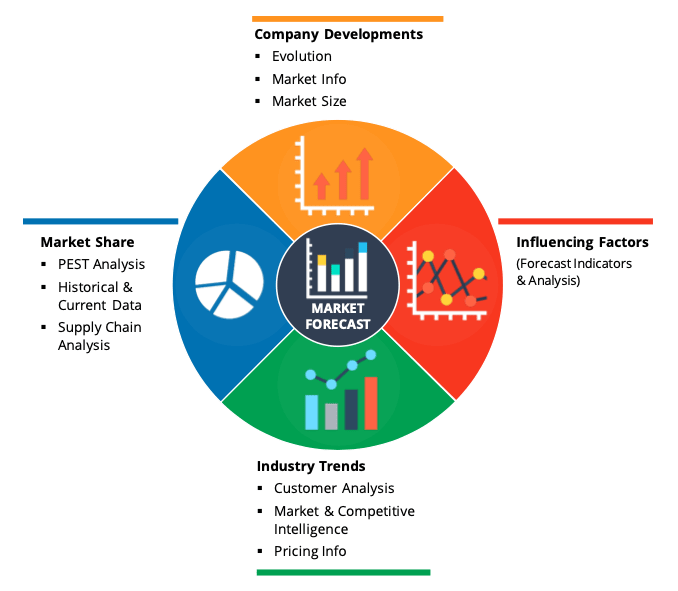The market value of seawater desalination plants is expected to reach USD 14.4 billion in 2023 and USD 24.1 billion in 2031, representing a Compound Annual Growth Rate (CAGR) of 8.5% from 2023 to 2031.
Get Complete Analysis Of The Report - Download Free Sample PDF
Seawater desalination plants are facilities designed to remove salt and other impurities from seawater, converting it into potable or industrial-grade freshwater. These plants play a critical role in addressing water scarcity challenges, especially in arid regions and coastal areas with limited freshwater resources. The market encompasses a variety of technologies, such as reverse osmosis, multi-stage flash (MSF) distillation, and multi-effect distillation (MED). Growth in this sector is driven by increasing demand for sustainable water solutions, rising population, and expanding industrial activities. Desalination is becoming a strategic investment for governments and private sectors looking to secure long-term water supplies.
Key drivers of the seawater desalination plant market include rising global water scarcity, particularly in arid and densely populated regions, prompting the need for alternative freshwater sources. Rapid urbanization, industrial expansion, and agricultural demands are further intensifying water consumption, placing pressure on existing supplies. Government initiatives and policies supporting sustainable water management, coupled with advancements in desalination technologies that reduce energy consumption and costs, are bolstering market growth. Additionally, climate change and unpredictable weather patterns are increasing reliance on desalination as a resilient and reliable water source.
The seawater desalination market is poised for significant growth, driven by increasing water scarcity and rising demand for clean drinking water globally. Key trends include the adoption of renewable energy sources, such as solar and wind power, to reduce carbon footprint and operating costs. Additionally, advancements in membrane technology and energy recovery systems are enhancing efficiency and reducing costs. Furthermore, there is a growing focus on sustainable and environmentally-friendly desalination solutions, including the use of reverse osmosis and hybrid systems. As a result, we expect to see increased investment in seawater desalination plants, particularly in regions with limited freshwater resources, such as the Middle East and North Africa.
Market Segmentation: The Global seawater desalination plants is segmented by technology (Reverse Osmosis (RO), Multi-Stage Flash (MSF), Multi-Effect Distillation (MED), Electrodialysis (ED), Hybrid Systems) End-User (Municipal, Industrial, Industrial) and geography (Asia-Pacific, North America, Europe, South America, and Middle-East and Africa). The report offers the market size and forecasts for revenue (USD million) for all the above segments.

For Detailed Market Segmentation - Get a Free Sample PDF
Market Drivers:
Water scarcity and climate change:
The increasing frequency and severity of droughts and water scarcity events are driving demand for seawater desalination plants. According to the World Bank, 40% of the global population lives in water-stressed areas, and this number is expected to rise to 50% by 2050. Climate change is exacerbating this issue, with rising temperatures and changing precipitation patterns leading to more frequent and severe droughts. As a result, governments and utilities are turning to desalination as a reliable source of clean drinking water. In fact, the Middle East and North Africa, which are particularly vulnerable to water scarcity, are expected to account for 70% of global desalination capacity growth by 2025.
Energy efficiency and sustainability:
The seawater desalination plants market is also being driven by advances in energy efficiency and sustainability. Traditional desalination methods are energy-intensive and have a high carbon footprint, but new technologies and innovations are changing this landscape. For example, the use of renewable energy sources, such as solar and wind power, is becoming increasingly common in desalination plants. Additionally, the development of more efficient membranes and energy recovery systems is reducing energy consumption and costs. As a result, we expect to see a shift towards more sustainable and environmentally-friendly desalination solutions, which will drive growth in the market.
Market Restraints:
Despite the growing demand for seawater desalination plants, high energy consumption and environmental concerns remain significant restraints on the market. Desalination is an energy-intensive process, requiring significant amounts of electricity to power the reverse osmosis membranes and other equipment. This has led to concerns about the carbon footprint of desalination, particularly in regions where renewable energy sources are limited. Additionally, the discharge of brine and other byproducts back into the ocean has raised environmental concerns, including the potential impact on marine ecosystems and the introduction of invasive species. As a result, regulators and stakeholders are increasingly demanding more sustainable and environmentally-friendly desalination solutions, which will require significant investments in research and development.
The COVID-19 pandemic had a mixed impact on the global seawater desalination plants market. On one hand, supply chain disruptions delayed ongoing projects, and workforce restrictions slowed down construction and maintenance activities. The economic uncertainty also led to postponed investments in new desalination infrastructure, particularly in emerging markets. On the other hand, the pandemic highlighted the importance of reliable water supplies for public health and industrial operations, driving governments and private sectors to prioritize critical water infrastructure. In the long term, this has reinforced the need for resilient, decentralized water systems, which is expected to boost demand for desalination plants post-pandemic.
Segmental Analysis:
Reverse Osmosis (RO) Segment is Expected to Witness Significant Growth Over the Forecast Period:
Reverse Osmosis (RO) is the dominant technology in the global seawater desalination market, accounting for over 60% of desalination capacity worldwide. RO systems use a membrane filtration process to separate salts and other impurities from seawater. The growing preference for RO is driven by its relatively lower energy consumption compared to thermal desalination methods, such as Multi-Stage Flash (MSF). Recent advancements in membrane technology, such as nanocomposite membranes, have improved efficiency and reduced operational costs, making RO even more attractive. The adoption of RO is particularly strong in the Middle East, with major projects like the Taweelah plant in Abu Dhabi, expected to be the world’s largest, highlighting the region's investment in water infrastructure. Increasing water scarcity, coupled with urbanization and industrial growth, is expected to further propel the demand for RO-based desalination.
Municipal Segment is Expected to Witness Significant Growth Over the Forecast Period
The municipal segment is one of the fastest-growing end-user categories in the seawater desalination market, as cities worldwide face growing freshwater shortages due to population growth and climate change. Governments in water-stressed regions, especially in the Middle East, North Africa, and parts of the U.S., are making significant investments in desalination to meet urban water demand. For instance, Saudi Arabia’s NEOM project includes large-scale desalination plants to supply water to its futuristic city. The municipal sector is increasingly adopting desalination as a long-term, sustainable water solution, with support from public-private partnerships driving development. Rising awareness of the need for water security and infrastructure resiliency in the face of climate-induced droughts is a key driving factor for the growth of desalination in the municipal sector.
Asia Pacific Region is Expected to Witness Significant Growth Over the Forecast Period
The Asia-Pacific region is poised to witness significant growth in the seawater desalination plants market over the forecast period. Rapid urbanization, industrial expansion, and growing population across countries such as China, India, and Australia are driving the demand for alternative freshwater sources. In China, water scarcity issues, particularly in coastal regions, have led to large-scale investments in desalination technologies, with the country planning to increase desalinated water production significantly by 2025. Australia, facing severe drought conditions and freshwater shortages, has also made notable strides in expanding its desalination capacity, including facilities like the Sydney Desalination Plant. Additionally, governments in this region are actively supporting desalination projects through favorable policies and infrastructure investments. The need for sustainable water solutions, alongside advancements in desalination technology, positions the Asia-Pacific market for robust growth during the forecast period.

To Learn More About This Report - Request a Free Sample Copy
The competitive landscape of the global seawater desalination plants market is highly consolidated, with a few key players dominating the market. Companies are focusing on strategic partnerships, technological advancements, and large-scale project developments to maintain their competitive edge.
Major competitors include:
Recent Development:
1) Veolia Water Technologies (2023): Veolia announced the successful commissioning of the Al Dur 2 Independent Water and Power Project (IWPP) in Bahrain, one of the largest desalination plants in the region. Utilizing advanced reverse osmosis (RO) technology, the plant has a capacity of 227,000 cubic meters per day, providing fresh water to over 1.2 million people. This project underscores Veolia’s strategic focus on expanding its presence in the Middle East and its commitment to enhancing water security in water-scarce regions. The plant also integrates energy-efficient processes, reducing overall operational costs and environmental impact.
2) SUEZ (2024): SUEZ, in partnership with the Dubai Electricity and Water Authority (DEWA), completed the Jebel Ali desalination plant, adding 150 million imperial gallons of water per day to Dubai’s supply. The plant leverages hybrid desalination technology combining reverse osmosis (RO) and multi-effect distillation (MED) to optimize energy use. This development is part of Dubai’s broader strategy to ensure sustainable water resources as the city’s population and industrial demand grow. SUEZ continues to lead in innovation by integrating renewable energy sources and energy recovery systems in desalination operations, reinforcing its market leadership in the region.
Q1. What are the driving factors for the Global Seawater Desalination Plants Market?
The Global Seawater Desalination Plants Market is primarily driven by increasing water scarcity due to population growth, urbanization, and climate change. As fresh water resources become more limited, many regions are turning to desalination as a viable solution to meet their water needs. Technological advancements in desalination processes, particularly in reverse osmosis, have improved efficiency and reduced costs, making these plants more accessible. Additionally, government initiatives and investments aimed at enhancing water security and sustainability further propel market growth. The rising demand for potable water in arid and semi-arid regions, coupled with industrial water requirements, also contributes significantly to the market's expansion.
Q2. What are the restraining factors for the Global Seawater Desalination Plants Market?
Despite its growth potential, the Global Seawater Desalination Plants Market faces several restraining factors. High capital and operational costs associated with building and maintaining desalination plants can deter investments, particularly in developing regions. Environmental concerns related to the disposal of brine, which can harm marine ecosystems, also pose challenges. Moreover, energy consumption is a significant issue, as desalination processes can be energy-intensive, leading to higher operational costs and a larger carbon footprint. Regulatory hurdles and the need for supportive policies may also limit the market's growth in certain areas, making it essential for stakeholders to navigate these challenges effectively.
Q3. Which segment is projected to hold the largest share in the Global Seawater Desalination Plants Market?
The reverse osmosis (RO) segment is projected to hold the largest share in the Global Seawater Desalination Plants Market. This technology is widely adopted due to its efficiency, lower energy requirements, and ability to produce high-quality potable water. Reverse osmosis systems are scalable and can be customized for various capacities, making them suitable for both small-scale and large-scale desalination projects. The growing preference for RO technology is driven by advancements that have reduced costs and improved system performance, positioning it as the dominant solution in the desalination landscape.
Q4. Which region holds the largest share in the Global Seawater Desalination Plants Market?
The Middle East holds the largest share in the Global Seawater Desalination Plants Market, primarily due to its arid climate and limited freshwater resources. Countries like Saudi Arabia, the United Arab Emirates, and Kuwait heavily rely on desalination to meet their water demands, making substantial investments in this technology. The region's focus on enhancing water security and sustainability, coupled with government-backed initiatives, further supports the expansion of desalination plants. Additionally, the Middle East's investment in advanced desalination technologies positions it as a global leader in the industry.
Q5. Which are the prominent players in the Global Seawater Desalination Plants Market?
Prominent players in the Global Seawater Desalination Plants Market include global leaders such as Veolia Water Technologies, SUEZ Water Technologies & Solutions, Acciona, IDE Technologies, and Fujitsu. These companies are known for their innovative solutions and extensive experience in water treatment and desalination projects. They actively invest in research and development to improve desalination processes and enhance operational efficiency. Partnerships and collaborations with governments and other stakeholders are common strategies for these companies to expand their market presence and contribute to sustainable water management solutions worldwide.
Data Library Research are conducted by industry experts who offer insight on industry structure, market segmentations technology assessment and competitive landscape (CL), and penetration, as well as on emerging trends. Their analysis is based on primary interviews (~ 80%) and secondary research (~ 20%) as well as years of professional expertise in their respective industries. Adding to this, by analysing historical trends and current market positions, our analysts predict where the market will be headed for the next five years. Furthermore, the varying trends of segment & categories geographically presented are also studied and the estimated based on the primary & secondary research.
In this particular report from the supply side Data Library Research has conducted primary surveys (interviews) with the key level executives (VP, CEO’s, Marketing Director, Business Development Manager and SOFT) of the companies that active & prominent as well as the midsized organization
FIGURE 1: DLR RESEARH PROCESS

Extensive primary research was conducted to gain a deeper insight of the market and industry performance. The analysis is based on both primary and secondary research as well as years of professional expertise in the respective industries.
In addition to analysing current and historical trends, our analysts predict where the market is headed over the next five years.
It varies by segment for these categories geographically presented in the list of market tables. Speaking about this particular report we have conducted primary surveys (interviews) with the key level executives (VP, CEO’s, Marketing Director, Business Development Manager and many more) of the major players active in the market.
Secondary ResearchSecondary research was mainly used to collect and identify information useful for the extensive, technical, market-oriented, and Friend’s study of the Global Extra Neutral Alcohol. It was also used to obtain key information about major players, market classification and segmentation according to the industry trends, geographical markets, and developments related to the market and technology perspectives. For this study, analysts have gathered information from various credible sources, such as annual reports, sec filings, journals, white papers, SOFT presentations, and company web sites.
Market Size EstimationBoth, top-down and bottom-up approaches were used to estimate and validate the size of the Global market and to estimate the size of various other dependent submarkets in the overall Extra Neutral Alcohol. The key players in the market were identified through secondary research and their market contributions in the respective geographies were determined through primary and secondary research.
Forecast Model
